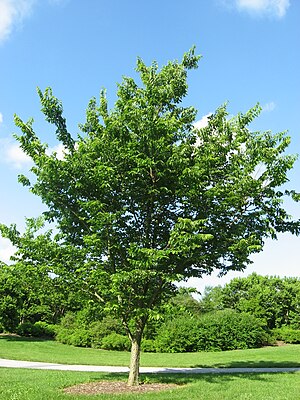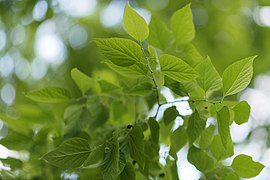American hackberry
| American hackberry | ||||||||||||
|---|---|---|---|---|---|---|---|---|---|---|---|---|

American hackberry ( Celtis occidentalis ) |
||||||||||||
| Systematics | ||||||||||||
|
||||||||||||
| Scientific name | ||||||||||||
| Celtis occidentalis | ||||||||||||
| L. |
The American hackberry or western hackberry ( Celtis occidentalis ) is a medium-sized deciduous tree from the genus of hackberry in the hemp family (Cannabaceae). The genus is often assigned to the elm family (Ulmaceae). The distribution area is in eastern Canada and the USA.
description
The American hackberry is an up to 25 meter high tree with broad, irregular crown and slightly overhanging branches. The bark is gray and deeply furrowed and becomes warty with age. The wood is light yellow. The branches have no thorns, the shoots are more or less hairy.
The leaves have a 0.5 to 1.2 centimeter long stem. The leaf blade is 5 to 12 centimeters long and 3 to 6, rarely up to 9 centimeters wide, ovate to broadly ovate, round-pointed to briefly pointed or pointed, with partly slate, rounded to blunt or slightly heart-shaped base and pointedly toothed to the base, sawn leaf edge. The upper side of the leaf is glossy green and smooth, the underside a little lighter and bare. The autumn color is golden yellow.
The sweet-tasting fruits grow on stems about 2 centimeters long. They are almost spherical, 7 to 11, rarely up to 20 millimeters in size, orange to dark purple. The cream-colored stone core is pitted, 7 to 9 millimeters long and 5 to 8 millimeters wide.
The number of chromosomes is 2n = 20.
- American hackberry
Distribution and ecology
The natural range extends from Ontario , Québec and Manitoba in Canada over the east and the middle to Texas in the south of the USA. The species was naturalized in Australia. It grows in species-rich forests up to an altitude of 1800 meters on moderately dry to fresh, slightly acidic to alkaline, nutrient-rich soils in sunny to light-shaded locations. The species loves warmth and is mostly frost hardy, it avoids sandy and clayey soils but is very good for urban climates.
The species often grows in company with the American elm ( Ulmus americana ), the red ash ( Fraxinus pennsylvanica ), the silver maple ( Acer saccharinum ), and various types of oak ( Quercus ).
Systematics
The American nettle tree ( Celtis occidentalis ) is a species from the genus of the nettle tree ( Celtis ). The genus, either the family of hemp plants assigned (Cannabaceae) or the family of elm plants (Ulmaceae). It was first scientifically described by Carl von Linné in his work Species Plantarum in 1753 .
In addition to the occidentalis variety , a distinction is also made between the Celtis occidentalis var. Cordata variety, which has hairy branches, coarse, oblong, ovoid leaves with a heart-shaped base, a rough leaf top and hairy leaf veins on the underside . Their distribution area is in the south of the USA.
use
The American hackberry tree is the most important forestry of the North American hackberry tree species. It is also widely used as a street tree because of its tolerance to drought. It is also popular as a park tree in Europe because it is harder than the southern hackberry tree ( Celtis australis ) found in Europe . In his homeland, decoctions made from the bark were used medicinally by the indigenous peoples as a remedy for menstrual pain and sore throat.
The sweet fruits are edible.
literature
- Andreas Roloff , Andreas Bärtels: Flora of the woods. Purpose, properties and use. With a winter key from Bernd Schulz. 3rd, corrected edition. Eugen Ulmer, Stuttgart (Hohenheim) 2008, ISBN 978-3-8001-5614-6 , p. 175.
- Schütt, Schuck, Stimm: Lexicon of tree and shrub species . Nikol, Hamburg 2002, ISBN 3-933203-53-8 , pp. 106 .
- Steve Cafferty: Cosmos Atlas Trees of the World . Franckh-Kosmos, Stuttgart 2008, ISBN 978-3-440-10983-0 , p. 162 .
Web links
- Celtis occidentalis at Useful Temperate Plants.
- Russell H. Burns: Silvics of North America . Volume 2: Hardwoods. In: Agriculture Handbook . United States Government Printing, Oxford 1991, ISBN 978-0-16-029260-6 ( Celtis occidentalis ).
- Thomas Meyer: Data sheet with identification key and photos at Flora-de: Flora von Deutschland (old name of the website: Flowers in Swabia )
Individual evidence
- ^ German name after Roloff et al .: Flora of the woods and Steve Cafferty: Kosmos-Atlas trees of the world
- ^ German name after Schütt, Schuck, Stimm: Lexikon der Baum- und Straucharten
- ↑ a b c Roloff et al .: Flora of the Woods , p. 175
- ↑ a b c d e Celtis occidentalis. In: Flora of North America Vol. 3. www.eFloras.org, accessed January 25, 2012 .
- ^ Erich Oberdorfer : Plant-sociological excursion flora for Germany and neighboring areas . 8th edition. Verlag Eugen Ulmer, Stuttgart 2001, ISBN 3-8001-3131-5 . Page 319.
- ↑ a b Celtis occidentalis. In: Germplasm Resources Information Network (GRIN). United States Department of Agriculture, accessed January 25, 2012 .
- ↑ a b Schütt et al .: Lexicon of Tree and Shrub Species , p. 106
- ^ Celtis occidentalis. In: The Plant List. Retrieved January 25, 2012 .




